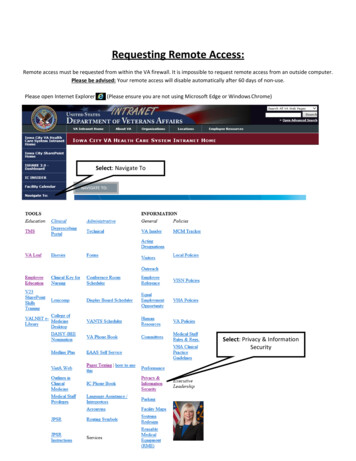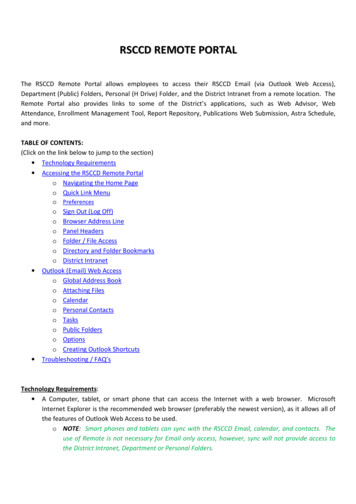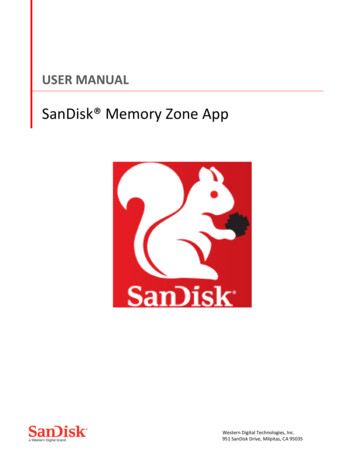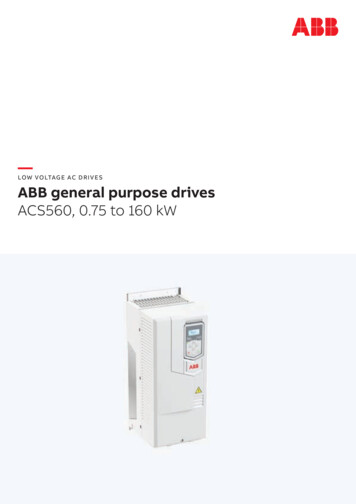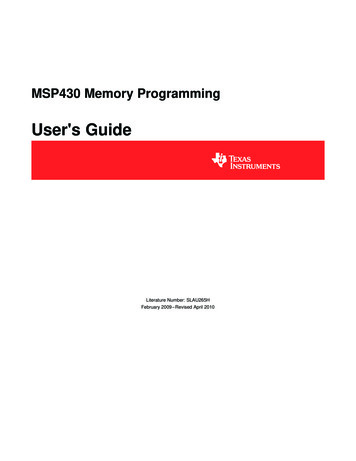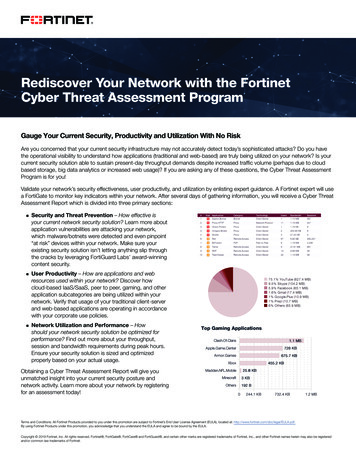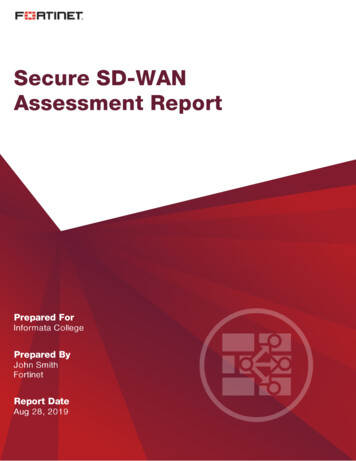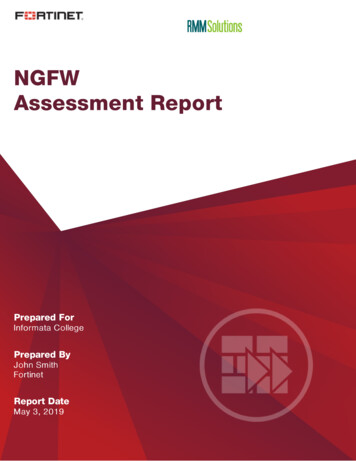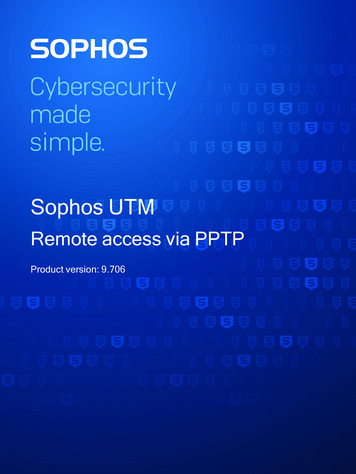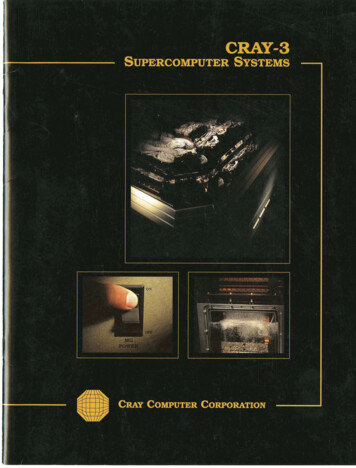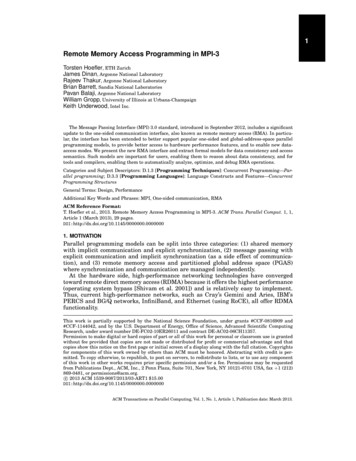
Transcription
1Remote Memory Access Programming in MPI-3Torsten Hoefler, ETH ZurichJames Dinan, Argonne National LaboratoryRajeev Thakur, Argonne National LaboratoryBrian Barrett, Sandia National LaboratoriesPavan Balaji, Argonne National LaboratoryWilliam Gropp, University of Illinois at Urbana-ChampaignKeith Underwood, Intel Inc.The Message Passing Interface (MPI) 3.0 standard, introduced in September 2012, includes a significantupdate to the one-sided communication interface, also known as remote memory access (RMA). In particular, the interface has been extended to better support popular one-sided and global-address-space parallelprogramming models, to provide better access to hardware performance features, and to enable new dataaccess modes. We present the new RMA interface and extract formal models for data consistency and accesssemantics. Such models are important for users, enabling them to reason about data consistency, and fortools and compilers, enabling them to automatically analyze, optimize, and debug RMA operations.Categories and Subject Descriptors: D.1.3 [Programming Techniques]: Concurrent Programming—Parallel programming; D.3.3 [Programming Languages]: Language Constructs and Features—ConcurrentProgramming StructuresGeneral Terms: Design, PerformanceAdditional Key Words and Phrases: MPI, One-sided communication, RMAACM Reference Format:T. Hoefler et al., 2013. Remote Memory Access Programming in MPI-3. ACM Trans. Parallel Comput. 1, 1,Article 1 (March 2013), 29 01. MOTIVATIONParallel programming models can be split into three categories: (1) shared memorywith implicit communication and explicit synchronization, (2) message passing withexplicit communication and implicit synchronization (as a side effect of communication), and (3) remote memory access and partitioned global address space (PGAS)where synchronization and communication are managed independently.At the hardware side, high-performance networking technologies have convergedtoward remote direct memory access (RDMA) because it offers the highest performance(operating system bypass [Shivam et al. 2001]) and is relatively easy to implement.Thus, current high-performance networks, such as Cray’s Gemini and Aries, IBM’sPERCS and BG/Q networks, InfiniBand, and Ethernet (using RoCE), all offer RDMAfunctionality.This work is partially supported by the National Science Foundation, under grants #CCF-0816909 and#CCF-1144042, and by the U.S. Department of Energy, Office of Science, Advanced Scientific ComputingResearch, under award number DE-FC02-10ER26011 and contract DE-AC02-06CH11357.Permission to make digital or hard copies of part or all of this work for personal or classroom use is grantedwithout fee provided that copies are not made or distributed for profit or commercial advantage and thatcopies show this notice on the first page or initial screen of a display along with the full citation. Copyrightsfor components of this work owned by others than ACM must be honored. Abstracting with credit is permitted. To copy otherwise, to republish, to post on servers, to redistribute to lists, or to use any componentof this work in other works requires prior specific permission and/or a fee. Permissions may be requestedfrom Publications Dept., ACM, Inc., 2 Penn Plaza, Suite 701, New York, NY 10121-0701 USA, fax 1 (212)869-0481, or permissions@acm.org.c 2013 ACM 1539-9087/2013/03-ART1 ACM Transactions on Parallel Computing, Vol. 1, No. 1, Article 1, Publication date: March 2013.
1:2T. Hoefler et al.Shared memory often cannot be emulated efficiently on distributed-memory machines [Karlsson and Brorsson 1998], and message passing incurs additional overheads on RDMA networks. Implementing fast message-passing libraries over RDMAusually requires different protocols [Woodall et al. 2006]: an eager protocol withreceiver-side buffering of small messages and a rendezvous protocol that synchronizes the sender. Eager delivery requires additional copies, and the rendezvous protocol sends additional control messages and may delay the sending process. The PGASmodel thus remains a good candidate for directly exploiting the power of RDMA networking.High-performance computing (HPC) has long worked within the message-passingparadigm, where the only means of communication across process boundaries is to exchange messages. MPI-2 introduced a one-sided communication scheme, but for a variety of reasons it was not widely used. However, architectural trends, such as RDMAnetworks and the increasing number of (potentially noncoherent) cores on each node,necessitated a reconsideration of the programming model.The Message Passing Interface Forum, the standardization body for the MPI standard, developed new ways for exploiting RDMA networks and multicore CPUs in MPIprograms. We summarize here the new one-sided communication interface of MPI3 [MPI Forum 2012], define the memory semantics in a semi-formal way, and demonstrate techniques for reasoning about correctness and performance of one-sided programs.This paper, written by key members of the MPI-3 Remote Memory Access (RMA)working group, is targeted at advanced programmers who want to understand the detailed semantics of MPI-3 RMA programming, designers of libraries or domain-specificlanguages on top of MPI-3, researchers thinking about future RMA programming models, and tool and compiler developers who aim to support RMA programming. For example, a language developer could base semantics of the language on the underlyingMPI RMA semantics; a tool developer could use the semantics specified in this paperto develop static-analysis and model-checking tools that reason about the correctnessof MPI RMA programs; and a compiler developer could design analysis and transformation passes to optimize MPI RMA programs transparently to the user.1.1. Related WorkEfforts in the area of parallel programming models are manifold. PGAS programmingviews the union of all local memory as a globally addressable unit. The two mostprominent languages in the HPC arena are Co-Array Fortran (CAF [Numrich andReid 1998]), now integrated into the Fortran standard as coarrays, and Unified Parallel C (UPC [UPC Consortium 2005]). CAF and UPC simply offer a two-level view oflocal and remote memory accesses. Indeed, CAF-2 [Mellor-Crummey et al. 2009] proposed the notion of teams, a concept similar to MPI communicators, but it has not yetbeen widely adopted. Higher-level PGAS languages, such as X10 [Charles et al. 2005]and Chapel [Chamberlain et al. 2007], offer convenient programmer abstractions andelegant program design but have yet to deliver the performance necessary in the HPCcontext. Domain-specific languages, such as Global Arrays [Nieplocha et al. 1996], offersimilar semantics restricted to specific contexts (in this case array accesses). MPI-2’sRMA model [MPI Forum 2009, §11] is the direct predecessor to MPI-3’s RMA model,and indeed MPI-3 is fully backward compatible. However, MPI-3 defines a completelynew memory model and access mode that can rely on hardware coherence instead ofMPI-2’s expensive and limited software-coherence mechanisms.In general, the MPI-3 approach integrates easily into existing infrastructures sinceit is a library interface that can work with all compilers. A complete specification of thelibrary semantics enables automated compiler transformations [Danalis et al. 2009],ACM Transactions on Parallel Computing, Vol. 1, No. 1, Article 1, Publication date: March 2013.
Remote Memory Access Programming in MPI-31:3for example, for parallel languages such as UPC or CAF. In addition, MPI offers a richset of semantic concepts such as isolated program groups (communicators), processtopologies, and runtime-static abstract definitions for access patterns of communication functions (MPI datatypes). Those concepts allow users to specify additional properties of their code that allow more complex optimizations at the library and compilerlevel. In addition, communicators and process topologies [Traff 2002; Hoefler et al.2011] can be used to optimize process locality during runtime. Another major strengthof the MPI concepts is the strong abstraction and isolation principles that allow thelayered implementation of libraries on top of MPI [Hoefler and Snir 2011].Since MPI RMA offers direct memory access to local and remote memory for multiple threads of execution (MPI processes), questions related to memory consistency andmemory models arise. Several recent works deal with understanding complex memorymodels of architectures such as x86 [Owens et al. 2009] and specifications for programming languages such as Java [Manson et al. 2005] and C 11 [Boehm and Adve2008]. We will build on the models and notations developed in those papers and definememory semantics for MPI RMA. The well-known paper demonstrating that threadscannot be implemented with a library interface [Boehm 2005] also applies to this discussion. Indeed, serial code optimization mixed with parallel executing schedule maylead to erroneous or slower codes. In this work, we define a set of restrictions for serialcompilers to make them MPI-aware.1.2. Contributions of This WorkThe specific contributions of this work are as follows.(1) Proposal of new semantics for a library interface enabling remote memory programming(2) Description of the driving forces behind the MPI-3 RMA standardization far beyond the actual standard text(3) Considerations for optimized implementations on different target architectures(4) Analysis of common use cases and examples2. OVERVIEW AND CHALLENGES OF RMA PROGRAMMINGThe main complications for remote memory access programming arise from the separation of communication (remote accesses) and synchronization. In addition, the MPIinterface splits synchronization further into memory synchronization or consistency(i.e., a remote process can observe a communicated value with a local read) and process synchronization (i.e., when a remote process gathers knowledge about the state ofa peer process). Furthermore, such synchronization can be nonblocking.The main challenges of RMA programming revolve around the semantics of operation completion and memory consistency. Most programming systems offer some kindof weak or relaxed consistency because sequential consistency is too expensive to implement. However, most programmers prefer to reason in terms of sequential consistency because of its conceptual simplicity. C 11 and Java offer sequential consistencyat the language level if the programmer follows certain rules (i.e., avoids data races).While Java attempts to define the behavior of programs containing races, C 11 leavesthe topic unspecified.MPI models consistency, completion, and synchronization as separate concepts andallow the user to reason about them separately. RMA programming is thus slightlymore complex because of complex interactions of operations. For example, MPI, likemost RMA programming models, allows the programmer to start operations asynchronously and complete them (locally or remotely) later. This technique is necessaryto hide single-message latency with multiple pipelined messages; however, it makesACM Transactions on Parallel Computing, Vol. 1, No. 1, Article 1, Publication date: March 2013.
1:4T. Hoefler et al.reasoning about program semantics much more complex. In the MPI RMA model, allcommunication operations are nonblocking; in other words, the communication functions may return before the operation completes, and bulk synchronization functionsare used to complete previously issued operations. In the ideal case, this feature enables a programming model in which high latencies can be ignored and processes never“wait” for remote completion.The resulting complex programming environment is often not suitable for averageprogrammers (i.e., domain scientists); rather, writers of high-level libraries can provide domain-specific extensions that hide most of the complexity. The MPI RMA interface enables expert programmers and implementers of domain-specific libraries andlanguages to extract the highest performance from a large number of computer architectures in a performance-portable way.3. SEMANTICS AND ARCHITECTURAL CONSIDERATIONSIn this section, we discuss the specific concepts that we use in MPI RMA programmingto enable performance-portable and composable software development.The two central concepts of MPI RMA are memory regions and process groups. Bothconcepts are attached to an object called the MPI window. A memory region is a consecutive area in the main memory of each process in a group that is accessible to allother processes in the group. This enables two types of spatial isolation: (1) no process outside the group may access any exposed memory, and (2) memory that is notattached to an MPI window cannot be accessed by any process, even in the correctgroup. Both principles are important for parallel software engineering. They simplifythe development and maintenance process by offering an additional separation of concerns; that is, nonexposed memory cannot be corrupted by remote processes. They alsoallow the development of spatially separated libraries in that a library can use eithera dedicated set of processes or a separate memory region and thus does not interferewith other libraries and user code [Hoefler and Snir 2011].MPI RMA offers the basic data-movement operations put and get and additionalpredefined remote atomic operations called accumulates. Put and get are designedto enable direct usage of the shared-memory subsystem or hardware-enabled RDMA.Accumulates can, in some cases, also use functions that are hardware-accelerated.All such communication functions are nonblocking. Communication functions arecompleted by using either bulk-completion functions (all synchronization functions include bulk completion as a side-effect) or single-completion (if special, generally slower,MPI-request-based communication operations are used). Figure 1 shows an overviewof communication options in the MPI specification.MPI 3.0MPI-3 RMAMPI completionpassivePost/Start/Complete/WaitFlush localLock/UnlockFlush local allFlushLock all/Unlock allFlush allaccumulateAccumulatefine grainedcompletionPutGet accumulateGetFetch and opCASFig. 1. Overview of communication options in the MPI-3 specification.ACM Transactions on Parallel Computing, Vol. 1, No. 1, Article 1, Publication date: March 2013.
Remote Memory Access Programming in MPI-31:53.1. Memory ExposureMPI RMA offers four calls to expose local memory to remote processes. The first threevariants create windows that can be remotely accessed only by MPI communicationoperations. Figure 2 shows an overview of the different versions. The last variant enables users to exploit shared-memory semantics directly and provides direct load/storeaccess to remote window memory if supported by the underlying . 2. MPI-3 memory window creation variants.The first (legacy) variant is the normal win create function. Here, each process canspecify an arbitrary amount ( 0 bytes) of local memory to be exposed and a communicator identifying a process group for remote access. The function returns a windowobject that can be used later for remote accesses. Remote accesses are always relativeto the start of the window at the target process, so a put to offset zero at process kupdates the first memory block in the window that process k exposed. MPI allows theuser to specify the block size for addressing each window (called displacement unit).The fact that processes can specify arbitrary memory may lead to large translationtables on systems that offer RDMA functions.The second creation function, win allocate, transfers the responsibility for memoryallocation to MPI. RDMA networks that require large translation tables for win createmay be able to avoid such tables by allocating memory at identical addresses on allprocesses. Otherwise, the semantics are identical to the traditional creation function.The third creation function, create dynamic, does not bind memory to the createdwindow. Instead, it binds only a process group where each process can use subsequentlocal functions for adding (exposing) memory to the window. This mode naturally mapsto many RDMA network architectures; however, it may be more expensive than allocated windows since additional structures for each registration may need to be maintained by the MPI library. This mode can, however, be used for more dynamic programsthat may require process-local memory management, such as dynamically sized hashtables or object-oriented domain-specific languages.3.2. Shared-Memory SupportShared-memory window allocation allows processes to directly map memory regionsinto the address space of all processes, if supported by the underlying architecture.For example, if an MPI job is running on multiple multicore nodes, then each of thosenodes could share its memory directly. This feature may lead to much lower overheadfor communications and memory accesses than going through the MPI layer. The winallocate shared function will create such a directly mapped window for process groupswhere all processes can share memory directly.The additional function comm split type enables programmers to determine maximum groups of processes that allow such memory sharing. More details on sharedmemory windows and detailed semantics and examples can be found in [Hoefler et al.2012]. Figure 3 shows an example of shared-memory windows on a dual-core systemwith four nodes.ACM Transactions on Parallel Computing, Vol. 1, No. 1, Article 1, Publication date: March 2013.
1:6T. Hoefler et al.Node 00Node 121eLoad/StoreLoad/Access4Node 35Load/Store Access67Load/Store AccessStorAccessNode 23Fig. 3. MPI-3 shared-memory window layout on a dual-core system with four nodes. Each node has its ownwindow that allows load/store and RMA accesses. The different shapes indicate that each process can pickits local window size independently of the other processes.3.3. Memory AccessOne strength of the MPI RMA semantics is that they pose only minimal requirementson the underlying hardware to support an efficient implementation. For example, theput and get calls require only that the data be committed to the target memory andprovide initiator-side completion semantics. Both calls make no assumption about theorder or granularity of the commits. Thus, races such as overlapping updates or readsconflicting with updates have no guaranteed result without additional synchronization. This model supports networks with nondeterministic routing as well as noncoherent memory systems.3.4. AccumulatesSimilar to put and get, accumulates strive to place the least possible restrictions onthe underlying hardware. They are also designed to take direct advantage of hardware support if it is available. The minimal guarantee for accumulates are atomicupdates (something much harder to achieve than simple data transport). The updateis atomic only on the unit of the smallest datatype in the MPI call (usually 4 or 8 bytes),which is often supported in hardware. For larger types that may not be supported inhardware, such as the “complex” type, the library can always fall back to a softwareimplementation.Accumulates, however, allow overlapping conflicting accesses only if the basic typesare identical and well aligned. Thus, a specification of ordering is required. Here, MPIoffers strict ordering by default, which is most convenient for programmers but maycome at a cost to performance. However, strict ordering can be relaxed by expert programmers to any combination of read/write ordering that is minimally required for thesuccessful execution of the program. The fastest mode is to require no ordering.Accumulates can also be used to emulate atomic put or get if overlapping accessesare necessary. In this sense, get accumulate with the operation no op will behave likean atomic read, and accumulate with the operation replace will behave like an atomicwrite. However, one must be aware that atomicity is guaranteed only at the level ofeach basic datatype. Thus, if two processes use replace to perform two simultaneous accumulates of the same set of two integers (either specified as a count or as adatatype), the result may be that one integer has the value from the first process andthe second integer has the value from the second process.3.5. Request-Based OperationsBulk local completion of communications has the advantage that no handles need tobe maintained in order to identify specific operations. These operations can run withlittle overhead on systems where this kind of completion is directly available in hardware, such as Cray’s Gemini or Aries interconnects [Alverson et al. 2010; Faanes et al.2012]. However, some programs require a more fine-grained control of local buffer reACM Transactions on Parallel Computing, Vol. 1, No. 1, Article 1, Publication date: March 2013.
Remote Memory Access Programming in MPI-31:7sources and thus need to be able to complete specific messages. For such cases, requestbased operations, MPI Rput, MPI Rget, MPI Raccumulate, and MPI Rget accumulate canbe used. These operations return an MPI Request object similar to nonblocking pointto-point communication that can be tested or can wait for completion using MPI Testand MPI Wait, or the equivalent. Here, completion refers only to local completion. ForMPI Rput and MPI Raccumulate operations, local completion means that the local bufferis to be reused. For MPI Rget and MPI Rget accumulate operations, local completionmeans that the remote data has been delivered to the local buffer.Request-based operations are expected to be useful in the model where the application issues a number of outstanding RMA operations and waits for the completionof a subset of them before it can start its computation. A common case would be forthe application to issue data fetch operations from a number of remote locations (e.g.,using MPI Rget) and process them out of order as each one finishes (see Listing 1).123456789101112131415i n t main ( i n t argc , char argv ){/ MPI i n i t i a l i z a t i o n and window c r e a t i o n /f o r ( i 0 ; i 100; i )MPI Rget ( buf [ i ] , 1000 , MPI DOUBLE, . . . , &req [ i ] ) ;while ( 1 ) {MPI Waitany ( 1 0 0 , req , &idx , MPI STATUS IGNORE ) ;p r o c e s s d a t a ( buf [ idx ] ) ;}}/ Window f r e e and MPI f i n a l i z a t i o n /return 0 ;Listing 1. Example (pseudo) code for using Request-based OperationsRequest-based operations allow for finer-grained management of individual RMAoperations, but users should be aware that the associated request management canalso cause additional overhead in the MPI implementation.3.6. Memory ModelsIn order to support different applications and systems efficiently, MPI defines twomemory models: separate and unified. These memory models define the conceptualinteraction with remote memory regions. MPI logically separates each window intoa private and a public copy. Local CPU operations (also called load and store operations) always access the local copy of the window whereas remote operations (get, put,and accumulates) access the public copy of the window. Figure 4 shows a comparisonbetween the two memory models.The separate memory model models systems where coherency is managed by software. In this model, remote updates target the public copy and loads/stores target theprivate copy. Synchronization operations, such as lock/unlock and sync, synchronizethe contents of the two copies for a local window. The semantics do not prescribe thatthe windows must be separate, just that they may be separate. That is, remote updatesmay also update the private copy. However, the rules in the separate memory modelensure that a correct program will always observe memory consistently. Those rulesforce the programmer to perform separate synchronization.The unified memory model relies on hardware-managed coherence. Thus, it assumesthat the private and public copies are identical; that is, the hardware automaticallypropagates updates from one to the other (without MPI calls). This model is closeto today’s existing RDMA networks where such propagation is always performed. ItACM Transactions on Parallel Computing, Vol. 1, No. 1, Article 1, Publication date: March 2013.
1:8T. Hoefler et al.getput,accput,accgetProcessprivate/public copystoreloadpublic copysynchronizationProcessprivate copystore(a) Unified memory modelload(b) Separate memory modelFig. 4. Unified and separate memory models.allows one to exploit the whole performance potential from architectures in which boththe processor and network provide strong ordering guarantees. Moreover, it places alower burden on the programmer since it requires less explicit synchronization.A portable program would query the memory model for each window and behaveaccordingly. Programs that are correct in the separate model are always also correct inthe unified model. Thus, programming for separate is more portable but may requireadditional synchronization calls.3.7. SynchronizationAll communication operations are nonblocking and arranged in epochs. An epoch isdelineated by synchronization operations and forms a unit of communication. All communication operations are completed locally and remotely by the call that closes anepoch (additional completion calls are also available and are discussed later). Epochscan conceptually be split into access and exposure epochs, where the process-local window memory can be accessed remotely only if the process is in an exposure epoch, anda process can access remote memory only while in an access epoch itself. Naturally, aprocess can be simultaneously in access and exposure epochs.MPI offers two main synchronization modes based on the involvement of the targetprocess: active target synchronization and passive target synchronization. In activetarget synchronization, the target processes expose their memory in exposure epochsand thus participate in process synchronization. In passive target synchronization, thetarget processes are always in an exposure epoch and do not participate in synchronization with the accessing processes. Each mode is targeted at different use cases. Active target synchronization supports bulk-synchronous applications with a relativelystatic communication pattern, while passive target synchronization is best suited forrandom accesses with quickly changing target processes.3.7.1. Active Target Synchronization. MPI offers two modes of active target synchronization: fence and general. In the fence synchronization mode, all processes associatedwith the window call fence and advance from one epoch to the next. Fence epochs arealways both exposure and access epochs. This type of epoch is best suited for bulksynchronous parallel applications that have quickly changing access patterns, such asmany graph-search problems [Willcock et al. 2011].In general active target synchronization, processes can choose to which other processes they open an access epoch and for which other processes they open an exposure epoch. Access and exposure epochs may overlap. This method is more scalablethan fence synchronization when communication is with a subset of the processes inthe window, since it does not involve synchronization among all processes. ExposureACM Transactions on Parallel Computing, Vol. 1, No. 1, Article 1, Publication date: March 2013.
Remote Memory Access Programming in MPI-31:9epochs are started with a call to post (which exposes the window memory to a selectedgroup) and completed with a call to test or wait (which tests or waits for the accessgroup to finish their accesses). Access epochs begin with a call to start (which maywait until all target processes in the exposure group exposed their memory) and finish with a call to complete. The groups of start and post and complete and wait mustmatch; that is, each group has to specify the complete set of access or target processes.This type of access is best for computations that have relatively static communicationpatterns, such as many stencil access applications [Datta et al. 2008]. Figure 5 showsexample executions for both active target modes.0fenceput321getputccget . 5. Active target synchronization: (left) fence mode for bulk-synchronous applications and (right) scalable active target mode for sparse applications.3.7.2. Passive Target Synchronization. The concept of exposure epoch is not relevant inpassive mode, since all processes always expose their memory. This feature leads toreduced safety (i.e., arbitrary accesses are possible) but also potentially to improvedperformance. Passive mode can be used in two ways: single-process lock/unlock as inMPI-2 and global shared lock accesses.In the single process lock/unlock model, a process locks the target process beforeaccessing it remotely. To avoid conflicts with local accesses (see Section 4), a processmay lock its local window exclusively. Exclusive remote window locks may be usedto protect conflicting accesses, similar to reader-writer locks (shared and exclusive inMPI terminology). Figure 6(a) shows an example with multiple lock/unlock epochs andremote accesses. The dotted lines represent the actual locked region (in time) whenthe operations are performed at the target process. Note that the lock function itself isa nonblocking function—it need not wait for the lock to be acquired.In the global lock model, each process starts a lock all epoch (it is by definitionshared) to all other processes. Processes then communica
Remote Memory Access Programming in MPI-3 1:3 for example, for parallel languages such as UPC or CAF. In addition, MPI offers a rich set of semantic concepts such as isolated program groups (communicators), process topologies, and runtime-static abstract definitions for access

